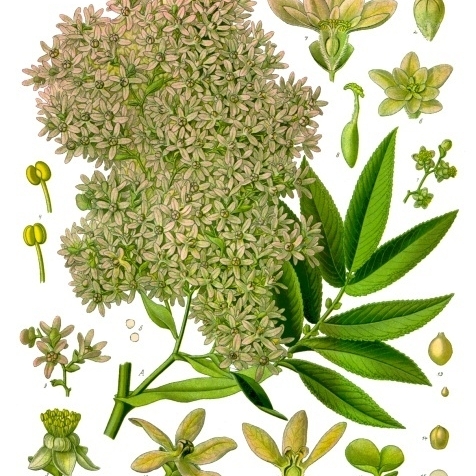Leaves imparipinnate, up to 40 cm. long, viscid; leaflets 5–7(8) on each side, usually 12–15 x 3·5–5·5 cm., subopposite, sessile or almost so, narrowly oblong, acuminate at apex, obliquely rounded to subcordate at the base, ± glabrescent above, densely silvery sericeous-villous to glabrescent below; margins finely dentate; main leaflet pairs alternating with 1(3) reduced subcircular ones, the latter with up to 5 teeth or minute and entire; rhachis and petiole with soft patent hairs up to 4 mm. long; petiole up to 15 cm. long; stipules (3)6–9 cm. long, membranous, reddish at first but becoming brown, adnate to petiole throughout almost their whole length.
Female and hermaphrodite flowers red, viscid, up to 1·5 cm. in diameter; calyx-tube c. 1 mm. long, obconical, densely hairy outside; epicalyx-lobes c. 1 x 0·4 cm., unequal, oblong-elliptic to obovate with apex obtuse, clearly veined, accrescent in fruit; calyx-lobes c. 3 x 2 mm., broadly ovate-acute with the apex acute, clearly veined; petals not seen (? absent or fugacious); stamens 0, or if present then fewer and smaller than in male flowers; carpels (1)2, apically villous, with styles c. 1·5 mm. long; stigmas 0·75 mm. wide, hairy.
Male flowers orange-buff to white, c. 8 mm. in diameter; calyx-tube obconical, c. 1·5 mm. long, densely hairy outside; epicalyx-lobes c. 1·5 x 0·5 mm., oblong; calyx-lobes 4–5 x 2·5–3 mm., oblong to obovate, recurved and with the abaxial surface concave, clearly veined; petals 1·5 mm. long, linear, fugacious (? or absent); stamens (8)10–15(20), anthers sparsely hairy; carpels vestigial, enclosed by the receptacle.
A tree. It grows 25 m high. The crown is rounded and often umbrella shaped. The bark is red-brown and is papery and peels off. The flowers are pinkish-white. They hang in long stalks and are of one sex.
Achenes enclosed within the calyx-tube with its accrescent epicalyx and persistent calyx-lobes; often only one of the achenes developing; pericarp thin, fragile, brown, reticulately rugose.
Branchlets densely sericeous-villous with golden antrorse hairs 3–4 mm. long, ringed by the scars of the fallen sheathing leaf-bases; scars at first villous, later glabrescent.
Panicles many-flowered, much-branched, terminal, drooping, up to 60 cm. long; female panicles bulkier than the male ones; flowers subtended by 2(3) broadly rounded bracts.
Tree up to 18 m. high, with globose or umbrella-shaped open crown; bark ridged and flaky, red-brown to brown.


